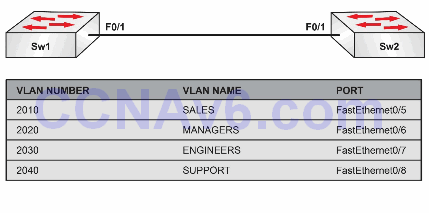Lab Objective:
The objective of this lab exercise is for you to learn and understand how to manually configure a switch to become the root bridge for a particular VLAN. By default, all VLANs have a priority of 32,768 (plus the VLAN number), which are used to determine the Spanning Tree root bridge.
Lab Purpose:
STP root bridge configuration is a fundamental skill. It is always recommended that the root bridge be manually configured to ensure that the Layer 2 network is deterministic. As a Cisco engineer, as well as in the Cisco CCNA exam, you will be expected to know how to configure a switch as a root bridge.
Certification Level:
This lab is suitable for ICND2 and CCNA certification exam preparation.
Lab Difficulty:
This lab has a difficulty rating of 6/10.
Readiness Assessment:
When you are ready for your certification exam, you should complete this lab in no more than 15 minutes.
Lab Topology:
Please use the following topology to complete this lab exercise:

Task 1:
Based on the topology above, configure a hostname on Sw1 and Sw2 and configure the VLANs listed.
Task 2:
Configure the switches to support the VLANs listed in the topology. Configure the VLANs and check that they are visible on both switches. Manually set the interface to trunk on one side.
Task 3:
Configure Sw1 as the root bridge for VLANs 2010 and 2030. Configure Sw2 as the root bridge for VLANS 2020 and 2040. Use the second non-zero priority value for root bridges.
Task 4:
Verify your configuration with the appropriate show commands.
Configuration and Verification
Task 1:
For reference information on configuring hostnames, please refer to earlier labs.
Task 2:
NOTE: By default, Cisco switches are VTP servers. However, to configure the extended range of VLANs (i.e., VLANs 1006 and above), you need to configure the switch as a VTP Transparent switch. For reference information on Transparent mode and extended VLANs, please refer to earlier labs.
Task 3:
NOTE: Spanning Tree priority values increment in amounts of 4096. The allowed values are illustrated on the switch if you issue an illegal value:
Sw1(config)#spanning-tree vlan2010 priority 4192 % Bridge Priority must be in increments of 4096. % Allowed values are: 0 4096 8192 12288 16384 20480 24576 28672 32768 36864 40960 45056 49152 53248 57344 61440 Sw1(config)#spanning-tree vlan2010 priority 8192 Sw1(config)#spanning-tree vlan2030 priority 8192 Sw2(config)#spanning-tree vlan2020 priority 8192 Sw2(config)#spanning-tree vlan2040 priority 8192
Task 4:
NOTE: Verify the same for VLAN2030 on Sw1, as well as for VLANs 2020 and 2040 on Sw2. In addition, you can also issue the show spanning-tree root command (it won’t work on Packet Tracer) to view the Spanning Tree root bridge for all VLANs in the domain. This is illustrated below:
Sw1#show spanning-tree root
Root Hello Max Fwd
Vlan Root ID Cost Time Age Dly Root Port
---------------- -------------------- ----- ----- --- --- ----------
VLAN2010 10202 000d.bd06.4100 0 2 20 15
Sw1#show spanning-tree vlan2010
VLAN2010
Spanning tree enabled protocol ieee
Root ID Priority 10202
Address 000d.bd06.4100
This bridge is the root
Hello Time 2 sec Max Age 20 sec Forward Delay 15 sec
Bridge ID Priority 10202 (priority 8192 sys-id-ext 2010)
Address 000d.bd06.4100
Hello Time 2 sec Max Age 20 sec Forward Delay 15 sec
Aging Time 15
Interface Role Sts Cost Prio.Nbr Type
---------------- ---- --- --------- -------- -------------------------
Fa0/1 Desg FWD 100 128.2 Shr
